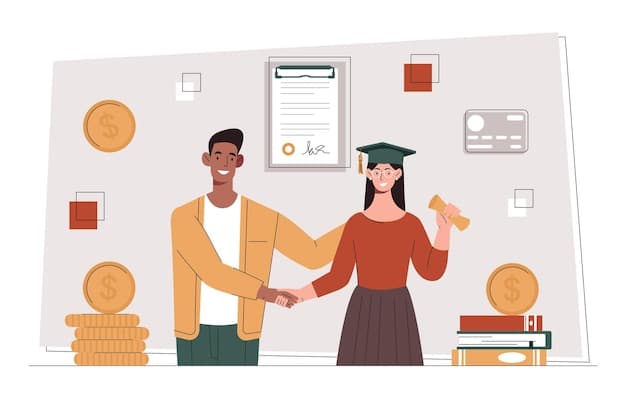Student Loan Forgiveness for Teachers: Your Complete Guide

Student Loan Forgiveness for Teachers offers eligible educators a chance to have a portion or all of their federal student loans discharged, incentivizing them to continue their valuable work in education.
Navigating the complex landscape of student loan forgiveness can be daunting for teachers. Fortunately, there are programs designed specifically to help educators manage and potentially eliminate their student debt. Understanding the eligibility requirements and application processes is key to accessing these valuable benefits.
Understanding Student Loan Forgiveness for Teachers
Many teachers grapple with student loan debt, which can be a significant financial burden. Recognizing this, the U.S. government offers several programs aimed at providing relief, allowing dedicated educators to focus more on their students and less on their loans. These programs offer a pathway to financial stability for teachers committed to serving their communities.
Student Loan Forgiveness for Teachers can take different forms, each with its own set of criteria and advantages. It’s essential to explore these options to determine which is the most suitable for individual circumstances. By understanding the nuances of each program, teachers can make informed decisions about their financial futures.

Teacher Loan Forgiveness Program: Eligibility Requirements
The Teacher Loan Forgiveness (TLF) program offers up to $17,500 in loan forgiveness for highly qualified teachers who serve for five consecutive academic years in a low-income school or educational service agency. This is a popular option, but it comes with specific requirements that must be met.
Eligible Loan Types
Not all federal student loans qualify for the Teacher Loan Forgiveness program. Understanding which loans are eligible is crucial for teachers planning to apply. It’s important to check the specific eligibility of your loan types to avoid disappointment later on.
- Federal Direct Loans
- Federal Stafford Loans (subsidized and unsubsidized)
- Federal Perkins Loans
“Highly Qualified” Teacher Definition
To qualify for TLF, you must be a “highly qualified” teacher. The definition varies based on when you were hired and what grade level you teach. Make sure you meet the specific criteria to avoid complications.
- Hold at least a bachelor’s degree
- Have full state certification
- Not have certification requirements waived on an emergency, temporary, or provisional basis
Qualifying Schools and Educational Service Agencies
To be eligible, you must teach full-time for five consecutive academic years at a qualifying low-income school or educational service agency. Annually, the Department of Education publishes a list of qualifying schools known as the Teacher Cancellation Low Income (TCLI) Directory.
- Schools and educational service agencies must be listed in the TCLI Directory.
- The TCLI Directory is usually updated annually.
- Check the directory for each year of teaching service to ensure eligibility.
In conclusion, the Teacher Loan Forgiveness program has stringent eligibility requirements focusing on loan type, teacher qualifications, and the schools where one teaches. Confirming you meet each of these requirements is vital before applying.
Public Service Loan Forgiveness (PSLF) for Teachers
The Public Service Loan Forgiveness (PSLF) program is another avenue for teachers seeking loan relief. Unlike TLF, PSLF isn’t exclusive to teachers but includes a broad range of public service occupations. It forgives the remaining balance on your Direct Loans after you’ve made 120 qualifying monthly payments while working full-time for a qualifying employer.
Qualifying Employment
The PSLF program requires full-time employment with a qualifying employer, which includes most public schools and non-profit educational organizations. It’s essential to know what employment qualifies under the PSLF rules.
- Employment can be with a federal, state, local, or tribal government.
- Non-profit organizations that are tax-exempt under Section 501(c)(3) of the Internal Revenue Code also qualify.
- Full-time employment is generally defined as working at least 30 hours per week.
Eligible Loan Types and Repayment Plans
PSLF only applies to Direct Loans. If you have loans from other programs, such as FFEL or Perkins loans, you’ll need to consolidate them into a Direct Consolidation Loan to become eligible, but before consolidating, ensure you won’t lose any benefits by consolidating.
- Only loans received under the William D. Ford Federal Direct Loan Program qualify.
- Income-Driven Repayment (IDR) plans are the most common path to PSLF.
- Standard 10-year repayment plans do not qualify.
The 120 Qualifying Payments
Making 120 qualifying payments is a critical requirement. These payments must be made while you’re working full-time for a qualifying employer and under a qualifying repayment plan. Careful record-keeping can prevent issues down the road.
- Payments must be made on time, typically within 15 days of the due date.
- A qualifying repayment is usually under an Income-Driven Repayment plan.
- Using the PSLF Help Tool can help to track progress.

In short, PSLF presents a longer-term strategy for student loan forgiveness for teachers, requiring 10 years of qualifying payments and full-time employment in public service. Correct preparation and consistent compliance are key to realizing the advantages of this program.
Comparing TLF and PSLF: Which is Right for You?
Choosing between the Teacher Loan Forgiveness (TLF) and Public Service Loan Forgiveness (PSLF) programs involves consideration of multiple variables. TLF offers a quicker route to forgiveness but with a lower maximum amount, while PSLF provides forgiveness of the entire remaining balance after 10 years of qualifying payments. Which program is best depends on individual circumstances.
Forgiveness Amount and Timeline
The amount of forgiveness and the time it takes to achieve it are essential factors in deciding between TLF and PSLF. Weighing these factors against your loan balance and career plans can guide your decision.
- TLF offers up to $17,500 in forgiveness after five years.
- PSLF offers forgiveness of the remaining loan balance after 10 years.
- Consider your loan balance and how quickly you want forgiveness.
Employment Requirements
The respective employment requirements of TLF and PSLF differ, and these qualifications influence eligibility and suitability. These requirements can impact your choice depending on your current and anticipated employment situation.
- TLF requires teaching at a low-income school for five consecutive years.
- PSLF requires full-time employment with a qualifying public service employer.
- Consider whether you can continuously meet the school requirements for TLF versus the broader public employment requirements for PSLF.
Loan Types and Repayment Plans
The types of loans and the eligible repayment plans under TLF and PSLF diverge, affecting your strategy. Understanding these variances will help you optimize your path to forgiveness.
- TLF is available for Federal Direct Loans, Federal Stafford Loans, and Federal Perkins Loans.
- PSLF is only available for Federal Direct Loans, potentially requiring consolidation.
- PSLF typically requires an Income-Driven Repayment plan, while TLF has no such stipulation.
Deciding between TLF and PSLF involves carefully weighing various elements, including loan amounts, employment scenarios, and repayment plans. Assess each program against your personal needs and long-term career goals to make an informed decision.
Step-by-Step Guide to the Teacher Loan Forgiveness Application Process
Applying for the Teacher Loan Forgiveness (TLF) program involves several key steps that must be followed to ensure successful application and approval. This process includes gathering documentation and completing the necessary forms accurately.
Gathering Required Documentation
Collecting all required documents ahead of time streamlines the application process. Knowing what you need to submit reduces the likelihood of delays or denials.
- Official transcripts
- Employment verification letters
- Loan documentation
Completing the Application Form
The application form must be completed precisely and accurately. Errors or omissions can cause delays or rejection of your application.
- Form must be fully completed with correct information.
- Double-check all entries for accuracy.
- Submit the form before the deadline.
Submitting Your Application
Once the application is completed and documentation is gathered, you need to submit the application to the appropriate loan servicer. Knowing the correct submission process helps to ensure timely processing.
- Understand the specific submission guidelines of your loan servicer.
- Keep a copy of the completed form and all submitted documents.
- Confirm receipt of your application by the loan servicer.
In conclusion, the Teacher Loan Forgiveness application process involves careful preparation, precise completion of forms, and adherence to submission guidelines. By following these steps closely, teachers can increase their chances of receiving loan forgiveness benefits.
Maintaining Eligibility and Avoiding Common Pitfalls
Once approved for a student loan forgiveness program, maintaining eligibility is crucial to ensure continued benefits. Staying informed about program rules and avoiding common mistakes helps teachers to successfully complete their forgiveness journey.
Annual Certification Requirements
Many forgiveness programs require annual certification to confirm continued eligibility. Failing to certify can interrupt or terminate benefits.
- Submit annual certification forms on time.
- Ensure all information on the certification form is accurate.
- Keep records of all submissions.
Changes in Employment
Changes in employment can impact your eligibility for loan forgiveness. Know how to manage these changes to stay qualified.
- Report any changes in employment promptly.
- Understand how changing schools or employers affects eligibility.
- Ensure that your new employment continues to qualify under program guidelines.
Staying Informed About Program Updates
Student loan forgiveness programs can change. Staying informed about updates ensures that you continue to meet all requirements.
- Regularly check program websites for updates.
- Subscribe to email alerts from the Department of Education.
- Attend webinars or workshops to stay informed.
In short, maintaining eligibility for teacher student loan forgiveness requires consistent attention to program guidelines, timely reporting of changes, and staying informed via official sources. Vigilance ensures that you continue enjoying the benefits to which you’re entitled.
Additional Resources and Support for Teachers
Navigating student loan forgiveness can be complex, and teachers may benefit from additional support and resources. Various organizations and tools are available to assist teachers in understanding and managing their student loans. These resources can help to make informed decisions and avoid common errors.
Department of Education Resources
The U.S. Department of Education offers a wealth of resources related to student loans and forgiveness programs. Leveraging these resources can enhance your understanding and decision-making.
- Federal Student Aid website
- Loan servicer websites
- Informational webinars and guides
Financial Counseling Services
Seeking advice from financial counseling services provides personalized guidance tailored to your specific situation. Professional advice can help you optimize your repayment and forgiveness strategies.
- Non-profit credit counseling agencies
- Financial advisors specializing in student loans
- Workshops and seminars on student loan management
Teacher Unions and Associations
Teacher unions and associations often provide resources and support related to student loans. These organizations can offer insights and assistance specific to the teaching profession.
- Information on loan forgiveness programs
- Advocacy and representation
- Peer support and networking
In summary, several resources and support systems are available to help teachers navigate student loan forgiveness. Utilizing these resources can lead to better-informed decisions and a smoother path to financial relief.
| Key Point | Brief Description |
|---|---|
| 🎓 Eligibility | Meet specific criteria: teaching field, school type, and loan type. |
| 📚 TLF vs PSLF | TLF offers quicker, limited forgiveness; PSLF forgives the balance after 10 years. |
| 📝 Application | Gather documents, complete the form, and submit to your loan servicer. |
| ✅ Maintaining Eligibility | Certify annually, report job changes, and stay updated on program changes. |
Frequently Asked Questions (FAQ)
Eligible teachers can receive up to $17,500 in loan forgiveness. Special education teachers and certain math and science teachers may qualify for the higher amount.
Check the Department of Education’s Teacher Cancellation Low Income (TCLI) Directory. The directory is updated annually and lists all qualifying schools.
No, you cannot receive benefits from both programs for the same period of service. However, you might use TLF first and then pursue PSLF afterward.
If you do not complete the required five years, the loans will revert to their original status, and you will be responsible for repaying them under the terms of your promissory note.
You can consolidate your loans into a Direct Consolidation Loan through the Federal Student Aid website. Be sure to carefully consider the implications before consolidating.
Conclusion
Student loan forgiveness programs offer invaluable support to teachers committed to serving their communities. Navigating these programs can transform financial challenges into opportunities to focus on what truly matters: educating and inspiring future generations. Armed with the right information, teachers can take control of their student debt and build a more secure financial future.





